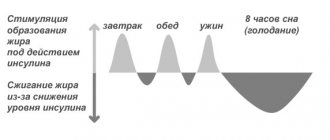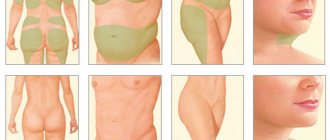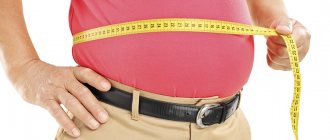- September 18, 2018
- Health
- Victoria Lovegood
To build a proper diet, you need to know not only effective exercises, but also the norm of muscle mass. This knowledge will allow you to adequately assess the state of your own body and monitor progress or degradation in training.
This norm is different for men and women. It also depends on the age, race and height of the person.
What is the normal amount of muscle mass in the human body? Let's try to figure it out.
Functions of muscle mass
Without muscle tissue, it would be impossible to smile or frown. A person would not be able to make a single movement, including breathing. He would just die.
A person cannot exist without muscles. After all, the heart also consists of muscle tissue, just like the internal organs.
Therefore, it is important to monitor your muscle mass, normalizing it and bringing it to ideal parameters. A lack of muscles depresses not only motor functions, but also the very functioning of the body.
Six reasons to maintain normal muscle mass
If it seems to you that everything is fine with your muscles, and you can forget about gymnastics, then think about how much benefit your muscles bring you.
- With a good muscular frame, you will have a “model” body. Any clothes will fit as if they were created just for you.
- If the muscle percentage is high, then your endurance and work performance will increase significantly. Down with fatigue and drowsiness!
- Having more muscle speeds up your metabolism.
- Your body will not only become stronger physically, but also improve the functioning of your immune system.
- You can't even imagine how strong you will be if your muscle mass is just above the generally accepted norm.
- A healthy and beautiful person is always confident in himself.
Well, do you want to increase the percentage of muscle mass in your body?
Physical Development Rating
This parameter evaluates your physical condition according to the ratio of fat to muscle mass in your body. If you become more active and your body fat decreases, your fitness rating will also change accordingly. Even if your overall weight does not change, your muscle and fat levels may change, making you healthier and reducing your risk of certain diseases. Each person must set their own fitness goals and follow a specific diet and exercise program to achieve that goal.
| Physical Development Rating | Explanations |
| 1. Hidden fullness | Small skeleton, obesity The person appears to have a healthy physical condition, but in fact there is a high fat content and low muscle mass. |
| 2. Full | Average skeleton, obesity The person has a high fat content and average muscle mass. |
| 3. Strongly built | Large skeleton, fullness The person has an average fat content and large muscle mass. |
| 4. Not trained enough | Low muscle mass and average body fat The person has average body fat and insufficient muscle mass. |
| 5. Standard | Average Muscle Mass and Fat % A person has average values for fat and muscle mass. |
| 6. Standard muscular | High Muscle Mass and Average Body Fat %/Athlete A person has high muscle mass and an average body fat percentage. |
| 7. Thin/thin | Low muscle mass and low fat % A person has low fat and muscle mass values. |
| 8. Skinny and muscular | Lean and Muscular A person has a low fat content but a sufficient amount of muscle mass. |
| 9. Very muscular | Very Muscular/Athlete The person has a low body fat but an above average amount of muscle mass. |
The above indicators can measure most analyzer scales and
Methods for measuring muscle mass
If you are faced with the need to take measurements of your muscle mass, then do not worry. There are several ways by which you can find out more or less accurate percentages of muscle mass, fat and water in your body.
- Measurements in clinics and hospitals. They can be considered a standard of accuracy, since in such institutions they monitor the adjustment of instruments. There are only two disadvantages: the inconvenience of constant monitoring and the need to pay for the procedure. They are unlikely to measure you for a “thank you.”
- You can purchase so-called smart bathroom scales. The pricing policy is quite pleasant; you can find a good gadget for 1,000 rubles. Of the minuses: the accuracy will be less than during an examination in a clinic, but it is not critical. The difference will be approximately 1-2% from hospital measurements, which is quite satisfactory. To track the norm of muscle mass, such a deviation is quite acceptable.
- You can take measurements yourself through measurements and calculations. This method is quite difficult to perform without outside help and does not give accurate results, unlike the first two.
Body water content (age limits 18-99 years)
Body water percentage is the total amount of fluid in the human body as a percentage of its total weight. Water plays a vital role in many processes in the human body and can be found in any cell, tissue or organ. Maintaining a healthy level of water in the body indicates that the body is functioning efficiently, which reduces the likelihood of developing problems in the body.
Eating, drinking alcohol, menstruation, illness, exercise and bathing can also cause fluctuations in hydration levels. Your body water percentage should serve as an indicator, but should not be used to determine the exact recommended body water percentage. It is important to analyze changes in body water over time while maintaining healthy body water levels.
Drinking a large amount of water at one time cannot significantly change the water content in the body. This will actually lead to higher fat levels because it will increase your overall body weight. Please monitor the unit's readings over time to determine relative changes. Each person is different, but the following values can be used as normal body water levels for adults:
- Women: 45-60%
- Men: 50-65%
Body water levels tend to decrease as a person's body fat increases. A person with high body fat may have lower than average body water levels. When you lose (decrease) the amount of fat in the body, the level of water content in the body will tend to the values indicated above.
Normal muscle mass in women
It is quite difficult to express the muscle norm for a woman as a percentage. It will change due to age, height and race. Ideally, the percentage of muscle mass in women should be about 40. That is, if a woman weighs 60 kg, then 24 kg of this weight should be muscle. However, on average this percentage rarely exceeds 36-37.
The structural features of the female body are such that the bulk of the muscles are distributed below: the hips, legs and lower abs swing much more easily than the muscles of the arms or chest. This is due to the natural purpose of procreation.
By the way, it is precisely because of the need to accumulate energy for the child that a woman needs to make more efforts to get rid of fat reserves. The body is extremely reluctant to part with what it has accumulated, secretly awaiting the onset of hungry days. And this can only be overcome through your own perseverance and hard work on yourself.
Normal lean body mass for men
Men gain weight more easily due to increased muscle mass. Thanks to testosterone, their body readily part with fat deposits and acquires the desired shape. It is much easier to meet “dry” men than women.
So, what can be considered normal muscle mass weight in men? For a man who is not too pumped up, the normal muscle mass is about 45%. With intense training, this ratio can be adjusted, making your figure leaner. It is quite possible to bring your body to 55% muscle mass, but further development will stall.
The body always acts based on its own benefit. Without support with special means and injections, no matter how much you train, you will not be able to achieve a muscle mass of 70% of your total body weight.
Why is it important to control your muscle mass?
The percentage of muscle in the body can be very different. If a person does not engage in physical work, then his muscles become decrepit and lose their weight. As a result, motor function and overall health deteriorate.
There are at least four reasons why it is necessary to control the weight of muscle mass in the body.
- A sharp drop in the percentage of muscles in the body can be considered a warning about a “breakdown” in the body. Perhaps an incorrect diet or excessive work in the gym is to blame.
- A decrease in muscle mass under unchanged living conditions can signal a disease that is hidden in the body.
- A high percentage of muscle in the body is the key to good health and longevity. A high level is considered to be one that exceeds the generally accepted norm by about 5%.
- A decrease in muscle volume may indicate dehydration. Make sure you drink enough water daily.
How many calories should you consume?
You can try to look for the exact amount of calories you need to consume daily in different sources, or you can calculate it yourself using a proven formula:
655 + 9.6 × (weight in kg) + 1.8 × (height in cm) – 4.7 × (age in years).
For example, for Anna at the age of 45 with a height of 172 cm and a weight of 86 kg, the formula will take the following form:
655 + 9.6 x 86 + 1.8 x 172 – 4.7 x 45 = 1,578.7 calories per day.
The result does not take into account physical activity. That is, we received the amount of calories needed during normal life.
If you do additional physical education, then you need to multiply the result by:
- 1.38 with one active session per week or morning exercises daily;
- 1.55 if a person is actively engaged three to five times a week;
- 1.73 if classes are held daily.
The resulting number can be considered the basis for further calculations.
For example, if you want to lose weight, then the calorie intake should be reduced by 20%.
For the growth and development of the muscle frame, you need to know the calorie intake for gaining muscle mass. Good news for food lovers: you can eat less restrictively if you want to build muscles! You will need to consume more calories to gain and increase the percentage of muscle mass in your body. The calorie intake in this case is 15% higher than the basic one.
This is a must. Muscles need energy to grow, but where will you get it if you cut your own calories?
Measuring muscle mass: how and why?
The problem with analyzing muscle mass is that, on the one hand, muscle mass is a kind of constant value, and in healthy people it approximately fits into one range of values. On the other hand, muscle mass and its increase mean an increase in body weight. Accordingly, you need to be sure that a person is “getting fat” because of muscles, and not because of fat. And finally, there is a direct problem with calculation as such: all available methods are quite approximate.
Let's talk about this. When we once again started testing the MGB scales, first of all, as you remember, we again turned to the problem of the accuracy of calculating the mass of fat in the body. This parameter is really important for all categories of people, while muscle mass seems to be of interest to “jocks” or, at a minimum, gym regulars.
And this is true: muscles are strength, endurance, the ability to lift heavy things and the aesthetic component, or appearance. Not everyone follows this and not everyone needs it. However, for example, for those who want to lose weight, they still need to monitor their muscle mass! For example, if you eat a low-calorie, low-protein diet, there is a high probability that a person will lose weight due to loss of muscle, not fat.
What's the trick?
Simply put: you can, in fact, assess changes in muscle mass only by eye. Seriously! In other words, we are back to the problem of burning fat, and not gaining muscle mass as such.
If you are trying to give your body definition, then you first gain some weight, eat it up, and then the “drying” process begins, and thus it turns out that you are not gaining muscle mass, but burning off excess fat, which is why analyzer scales are primarily are valuable to us because they help control this parameter with sufficient accuracy.
The second trick is that muscle mass is a certain constant value, the range of values of which for a healthy person is approximately the same:
For men: normal muscle mass is about 45% of total body weight For women: normal muscle mass is about 35% of total body weight
For those who work out systematically in the gym, the figure can increase to 50-55%, and for “regular” bodybuilders, up to 70%, but there are pills, injections and a lot of money.
This is not our method! On a smart scale this can be expressed this way:
On the left is the measurement of a person who regularly goes to the gym, on the right is an ordinary office worker.
Is there a system in these dimensions? Yes, I have. For example, if we compare the indicator of a person who simply systematically works out in the gym, pursuing his own interests, with the data of a martial arts coach, the picture will be different:
How accurate is this?
And here is the second trick. There is nothing to compare it with! More precisely, not even like that. The thing is that in most sources, one word is removed from the phrase “Muscle mass”, which is the secret. There are two muscle masses: Lean Body Mass
and
Skeletal Muscle Mass
.
They cannot be compared, and modern diagnostics, primarily bioimpedance analysis and DEXA analysis, calculate different
meanings! DEXA shows “Lean”, and bioimpedance “Skeletal”, hence the difference:
Three values: bioimpedance in the clinic, smart scales MGB, DEXA
In other words, on the x-ray you see a complex figure for the content of muscles, water in muscles and cells, which can constitute a significant proportion, and this also does not characterize the relief of the body in any way!
If you set a goal, then, of course, it is possible to adjust the values, since bioimpedance analysis shows both extracellular fluid and general fluid, which can be divided into muscles, but this is already a so-so story.
In other words, for this parameter: skeletal muscle mass bioimpedance can only be compared with bioimpedance, and it is completely impossible
, despite the formulas for calculating muscle mass, of which there are plenty on the Internet.
Bioimpedance analysis in the clinic and MGB smart scales
The skeletal muscle mass with which we are dealing is a certain conditional indicator of the body’s health, endurance and physical development. Lean Mass is largely “gained” due to fluid and connective tissue; it is difficult to say exactly what percentage of skeletal muscle mass in this indicator. As a result, it must be said that neither of the two indicators characterizes the relief of the body! Although, judging by the data, the indicator of scales is closer to “lean muscle mass” than an x-ray.
What does the Internet say?
The potential of a normal person without drugs and doctors, as noted, is up to 12 kg of muscle per year with uniform sports loads, decreasing from year to year to 6 and 3 kg, respectively. Instant recruitment is almost impossible without additional stimulation, but the effect of this is quick and not always useful.
A good example of a quick effect are actors who can afford to quickly gain weight and muscle mass and quickly get rid of it, and then gain it again.
It's expensive and unhealthy, but Hollywood stars have money and can simply afford it. Most ordinary people strive to correct their figure much more systematically, and the system gives results, but in our system it is enough to stick to values close to the normal range, and this can be observed in trends using smart scales.
Also, we must not forget that myostatin is responsible for muscle growth, and some people are genetically limited in their ability to endlessly grow muscle.
Somehow else? Yes! Let's try with a caliper
When we were just starting to talk about scales as a way to analyze the body, experts immediately appeared who (partly and rightly) questioned the bioimpedance method in principle.
A truly in-depth, detailed analysis of body composition is only possible with the help of X-rays - DEXA. However, mathematics is also suitable for tracking trends: and somewhere, a regular calculator.
Do you want to compare a study for 10,000 rubles on average with the results of a centimeter for 10 rubles on average?
| Data | Online | DEXA |
| Fat mass in % | 16 | 19,7 |
| Fat mass in kg | 10 | 11,9 |
| Lean Mass | 54 | Muscle mass + connective tissue + fluids - 48.6 |
For such calculations, just use this calculator. Of course, there is a difference, but not so catastrophic, it is clear that the person is thin, everything is within the normal range.
To calculate skeletal muscle mass, you can also use a calculator, albeit a little more “demanding”.
| Data | MGB | Online |
| Muscle mass | 28,5 | 28 |
Something like this…
Lost in translation?
The first thing that came to mind: Lean Body Mass can be translated in different ways: both as “muscle mass”, and as “lean” or “dry” body mass, or as fat-free. And it would be very logical. Indeed: everything that is not fat must be muscle.
Everything speaks in favor of this version, except for one tiny discrepancy: in the DEXA study there are two columns: lean body mass and Lean Body Mass, and there are slightly different numbers: that means they are not the same thing.
| Data | DEXA | DEXA 2 units |
| Lean mass | 51,4 | 64 |
| Lean Body Mass | 48,6 | 60,4 |
However, the numbers are still suspiciously close! And this assessment method, simplified by the formula “ everything that is not fat is muscle
,” can be kept in mind. And here the difference between bioimpedance and DEXA will be insignificant:
| Data | MGB | DEXA |
| Lean mass 1 | 49,6 | 51,4 |
| Lean mass 2 | 66 | 64 |
In general, this indicator - beige body mass - DEXA is already comparable to the bioimpedance measurement.
As a result, we must admit that when designating “Muscle mass”, different studies and analyzes imply different data. Secondly, it should be noted that muscles, muscle mass is not the same as relief, and this term should rather be understood as a certain indicator of body strength, endurance and physical fitness: close to athletic or, conversely, to obesity. And here everything is inseparable from the fat mass: how much is it? Weight is gained both from fat and from muscles, and with a weight of 100+ kg, muscle mass can be calculated proportionally, but with a round belly instead of abs - you, unfortunately, are not an athlete.
We also note that analyzer scales, since they are based on bioimpedansometry technology, measure skeletal muscle mass, which has a certain normal range, which is not so difficult for a healthy person to reach.
And, perhaps, today this particular indicator cannot be approximately calculated in any other way except with hands and a caliper. However, in order to calculate this data with a caliper and a centimeter, you still need to know your own weight, and then the circle is closed - it’s time to buy scales.
We propose to use the MGB model: lightweight, compact and comfortable, which has undergone a number of tests and comparisons on different people, including in comparison with classical clinical studies using a bioimpedance meter and the DEXA device.
The scales were primarily tested for their ability to calculate fat mass, and in this regard they were very convincing.
| Data | MGB | DEXA |
| Fat mass in % | 21,4 | 19,7 |
| Fat mass in kg | 13,6 | 11,9 |
| Lean mass | 49,6 | 51,4 |
| Metabolism | 1348 Kcal/day | 1427 Kcal/day |
And the second dimension with another participant:
| Data | MGB | DEXA |
| Fat mass in % | 37 | 38,6 |
| Fat mass in kg | 38,7 | 37,8 |
| Lean mass in kg | 66 kg | 64 kg |
| Metabolism | 1829 Kcal/day | 1673 Kcal/day |
In other words, it seems to us that the scales are capable of quite reliably processing a number of data related to body weight and dividing it into fat/lean/muscle mass. First of all, this will help to better monitor your weight and the dynamics of changes with some detail. also subscribe to systematic mailing of coupons to buy everything cheaper.
Norm BZHU
It is necessary to focus not only on calorie content, but also on the BJU norm. To gain muscle mass, the ratio of proteins, carbohydrates and fats may be even more important than calorie intake.
To calculate your BZHU norm, you still have to calculate the required calorie content. It will be needed to display the intake rates for fats, proteins and carbohydrates.
Calorie content of BJU:
- 4.5 kcal per 1 gram of protein;
- 4.5 kcal per 1 gram of carbohydrates;
- 9 kcal per 1 gram of fat.
To gain muscle mass, you need to adhere to the following ratio: 45% protein, 25% fat, 30% carbohydrates.
Let's calculate the norm of BZHU for Anna, already familiar to us, who decided to lose weight. She works out in the gym 3 times a week, which means her daily caloric intake is:
1,578.7 x 1.55 - 20% = 1,958 calories.
This works out to: 881.1 calories from protein, 489.5 from fat and 587.4 from carbohydrates. The obtained values must be converted into grams, for which we divide them by the calorie content of the BJU presented above. This yields approximately 196 grams of protein, 54 grams of fat and 131 grams of carbohydrates.
The BZHU for weight gain is calculated similarly. The ratio is 35-40% protein, 15-20% fat and 40-50% carbohydrates.
How is the BZHU norm calculated for weight maintenance? To do this, you need to consume approximately 1 gram of protein and 1.1 grams of fat and 4 grams of carbohydrates per 1 kilogram of weight. The BJU norm in this case is individual, so at first you will have to adjust your diet.
If you want to calculate the norm of BJU for maintaining weight according to the previous scheme, then the ratio is as follows: 25% protein, 30% fat and 45% carbohydrates.
Never exclude fats from your menu! This can be detrimental to your health!
Sports nutrition for gaining lean mass
Should I use sports supplements to gain muscle mass without fat? Sports nutrition for gaining lean muscle mass is an indispensable element of an athlete’s diet. At the same time, you need to take not just one type of sports nutrition, but several different types:
- Whey Protein: This product is a concentrated protein mixture derived from whey. Proteins are widely used by athletes and bodybuilders, as they allow for effective growth of muscle tissue and guarantee rapid fat burning;
- casein: a special type of protein obtained from dairy products, entering the athlete’s stomach, it provides long-term saturation of the body with amino acids, and also relieves hunger;
- Creatine monohydrate: This is one of the most common forms of creatine and is an indispensable form of sports nutrition for people who want to gain muscle mass. In addition, its use helps to increase strength and endurance;
- BCAA: These essential amino acids not only take part in the formation of protein, but are also an important source of energy;
- vitamin and mineral complexes: the use of vitamins is a mandatory requirement for professionals and amateur athletes, because they improve metabolism and also contribute to the proper functioning of hormones and enzymes.
Top products for fat burning
The main experts consider the following.
- Vegetables and greens. Thanks to fiber, they are perfectly satiating without adding extra calories.
- Egg white. An indispensable product in the difficult task of losing weight.
- Lenten bird. It can be turkey or chicken, and you need to choose the breast. Unfortunately, the rest of the meat contains too much fat, so you will have to give it up or seriously reduce its consumption to a couple of times a month.
- Citrus. Make special mention of grapefruit. Several very effective diets have been built on the constant use of this fruit.
- Celery. Its calorie content is so low that when consumed, the body expends more energy to digest it than it receives from it. Energy deficiency causes weight loss.
Types of diets for those seeking to achieve a “dried” body
There are several diets that help you gain lean muscle mass.
No carbohydrate diet
This way of eating involves minimizing the consumption of foods that include carbohydrates and focusing on protein foods. Mostly this includes: chicken breasts, egg whites (don’t forget that the yolks also contain fat), white meat, fish with minimal fat content, seafood. All of the above can be steamed or grilled, as well as boiled - frying is completely excluded.
Diet based on carbohydrate rotation
With carbohydrate cycling, you deliberately do not give your body even the slightest opportunity to get used to any specific amount of carbohydrates it receives. For example, every day, from the complete absence of consumed carbohydrates, an athlete increases their volume by 50 g - this continues for a week. Starting next Monday, this process starts again. The great thing about carb cycling is that it doesn't slow down your metabolism.
Low calorie diet
This diet reduces the number of calories consumed and is considered effective for increasing lean muscle mass. Protein foods are consumed more often, as well as foods that include complex carbohydrates, which gradually increase blood sugar levels.
Top foods for muscle growth
In fact, it is large, but here we will highlight the main ones.
- Milk. Choose whole milk, it is much healthier than skim milk. Milk accelerates protein synthesis in muscles, which helps accelerate their growth.
- Cottage cheese. Casein in its composition is absorbed by the human body very slowly. Because of this, a constant amount of amino acids necessary for muscle growth is maintained in the blood.
- Eggs. The leucine they contain slows down the rate of muscle tissue breakdown.
- Beef. It contains a set of amino acids similar to human ones. For building muscle, beef is as effective as protein.
- Chicken breast. It has an effect on the body similar to beef. Most of all kinds of diets for both weight loss and weight gain include this meat.
- Chickpeas For vegetarians, chickpeas can be a complete replacement for meat dishes.
- Fish. Choose the following types: cod, salmon, tuna, trout, mackerel, chum salmon, pink salmon or mackerel. This fish contains a lot of easily digestible protein and amino acids necessary for life. It's simple: the fattier the fish, the healthier it is. And there is no need to worry about the dangers of this fat, because if you eat fish once or twice a week, it will not cause harm.
How should you train?
The choice of training program for gaining lean muscle mass depends on the individual characteristics of each athlete. It matters a lot how you trained before and how accustomed your body is to intense weight gain. We offer an approximate list of workouts for building lean muscle tissue.
For the upper body:
- lifting the barbell in a lying position;
- lifting the block in a sitting position;
- lifting dumbbells;
- biceps curl;
- push-ups on parallel bars.
For the lower body:
- lifting weights with your legs on a machine;
- squats;
- deadlift.
It is important to remember that training should not be of the same type, and therefore cardio and a variety of strength training should be introduced, aimed at all muscle groups. This approach will allow the body to burn fat more efficiently. In addition, you can replace exercises in the gym with cycling or running. At the same time, regardless of what type of load you choose, you must not forget about the preliminary warm-up and cool-down.
In addition, while gaining lean muscle mass, you need to remember to rest. If you visit the gym every day, it will not bring much benefit. Therefore, it is best to train three to four times a week, allowing the body to recover.
How to gain muscle mass if it is below normal?
If you have never done physical exercise or abandoned it a long time ago, then you should start immediately. You don't need any additional miracle exercise equipment to do exercises at home. To increase the percentage of muscles in the body and normalize metabolism, just three exercises are enough:
- Classic squats.
- Full rack push-ups.
- Plank position on elbows.
These general exercises, if performed daily, will allow you to tighten your skin, make your muscles more prominent and begin the fat burning process.
However, pay attention to the technique of their implementation: the slightest deviations can reduce the effectiveness of the exercise many times over, and with a low percentage of muscle mass, it can also become extremely traumatic.
How to measure your body fat percentage at home?
You can calculate the percentage of body fat at home. These measurement methods are less accurate and only measure subcutaneous fat.
- Visual. To find out the amount of fat, you need to compare your figure with photographs presented on sports sites. This is one of the most unreliable measurement methods.
- An online calculator is a quick method that does not require complex calculations, but the calculations are most often not accurate.
- By body mass index. This measurement method is only suitable for beginners in the sport.
- Scales with analyzer. This device works on the principle of bioimpedancemetry, when a weak electric current is passed through the body. This method of measurement is quite accurate provided that the weighings are carried out under the correct conditions.
- Using a caliper - a special device that measures the thickness of the body fold. The most accurate way to measure at home. If such a device is not at hand, then you can measure the percentage of fat using a caliper or an adjustable wrench. To determine the percentage of fat, you need to take several measurements: on the stomach to the right of the navel, in the middle of the forearm from the biceps and triceps, on the shoulder blade. To do this, grab the fold with your fingers, pull it back and measure its thickness with a caliper. The results obtained are added up and checked against the data in the table. Measurements using a caliper give results with an error of 3-5%.
Subcutaneous fat content (%) in women:
| Age | Fold thickness (mm) | |||||||||||||||
| 2-3 | 4-5 | 6-7 | 8-9 | 10-11 | 12-13 | 14-15 | 16-17 | 18-19 | 20-21 | 22-23 | 24-25 | 26-27 | 28-29 | 30-31 | 32-33 | |
| 18-20 | 11,3 | 13,5 | 15,7 | 17,7 | 19,7 | 21,5 | 23,2 | 24,8 | 26,3 | 27,7 | 29 | 30,2 | 31,3 | 32,3 | 33,1 | 33,9 |
| 21-25 | 11,9 | 14,2 | 16,3 | 18,4 | 20,3 | 22,1 | 23,8 | 25,5 | 27 | 28,4 | 29,6 | 30,8 | 31,9 | 32,9 | 33,8 | 34,5 |
| 26-30 | 12,5 | 14,8 | 16,9 | 19 | 20,9 | 22,7 | 24,5 | 26,1 | 27,6 | 29 | 30,3 | 31,5 | 32,5 | 33,5 | 34,4 | 35,2 |
| 31-35 | 13,2 | 15,4 | 17,6 | 19,6 | 21,5 | 23,4 | 25,1 | 26,7 | 28,2 | 29,6 | 30,9 | 32,1 | 33,2 | 34,1 | 35 | 35,8 |
| 36-40 | 13,8 | 16 | 18,2 | 20,2 | 22,2 | 24 | 25,7 | 27,3 | 28,8 | 30,2 | 31,5 | 32,7 | 33,8 | 34,8 | 35,6 | 36,4 |
| 41-45 | 14,4 | 16,7 | 18,8 | 20,8 | 22,8 | 24,6 | 26,3 | 27,9 | 29,4 | 30,8 | 32,1 | 33,3 | 34,4 | 35,4 | 36,3 | 37 |
| 46-50 | 15 | 17,3 | 19,4 | 21,5 | 23,4 | 25,2 | 26,9 | 28,6 | 30,1 | 31,5 | 32,8 | 34 | 35 | 36 | 36,9 | 37,6 |
| 51-55 | 15,6 | 19,7 | 20 | 22,1 | 24 | 25,9 | 27,6 | 29,2 | 30,7 | 32,1 | 33,4 | 34,6 | 35,6 | 36,6 | 37,5 | 38,3 |
| 56+ | 16,3 | 18,5 | 20,7 | 22,7 | 24,6 | 26,5 | 28,2 | 29,8 | 31,3 | 32,7 | 34 | 35,2 | 36,3 | 37,2 | 38,1 | 38,9 |
Subcutaneous fat content (%) in men:
| Age | Fold thickness (mm) | |||||||||||||||
| 2-3 | 4-5 | 6-7 | 8-9 | 10-11 | 12-13 | 14-15 | 16-17 | 18-19 | 20-21 | 22-23 | 24-25 | 26-27 | 28-29 | 30-31 | 32-33 | |
| 18-20 | 2 | 3,9 | 6,2 | 8,5 | 10,5 | 12,5 | 14,3 | 16 | 17,5 | 18,9 | 20,2 | 21,3 | 22,3 | 23,1 | 23,8 | 24,3 |
| 21-25 | 2,5 | 4,9 | 7,3 | 9,5 | 11,6 | 13,6 | 15,4 | 17 | 18,6 | 20 | 21,2 | 22,3 | 23,3 | 24,2 | 24,9 | 25,4 |
| 26-30 | 3,5 | 6 | 8,4 | 10,6 | 12,7 | 14,6 | 16,4 | 18,1 | 19,6 | 21 | 22,3 | 23,4 | 24,4 | 25,2 | 25,9 | 26,5 |
| 31-35 | 4,5 | 7,1 | 9,4 | 11,7 | 13,7 | 15,7 | 17,5 | 19,2 | 20,7 | 22,1 | 23,4 | 24,5 | 25,5 | 26,3 | 27 | 27,5 |
| 36-40 | 5,6 | 8,1 | 10,5 | 12,7 | 14,8 | 16,8 | 18,6 | 20,2 | 21,8 | 23,2 | 24,4 | 25,6 | 26,5 | 27,4 | 28,1 | 28,6 |
| 41-45 | 6,7 | 9,2 | 11,5 | 13,8 | 15,9 | 17,8 | 19,6 | 21,3 | 22,8 | 24,7 | 25,5 | 26,6 | 27,6 | 28,4 | 29,1 | 29,7 |
| 46-50 | 7,7 | 10,2 | 12,6 | 14,8 | 16,9 | 18,9 | 20,7 | 22,4 | 23,9 | 25,3 | 26,6 | 27,7 | 28,7 | 29,5 | 30,2 | 30,7 |
| 51-55 | 8,8 | 11,3 | 13,7 | 15,9 | 18 | 20,2 | 21,8 | 23,4 | 25 | 26,4 | 27,6 | 28,7 | 29,7 | 30,6 | 31,2 | 31,8 |
| 56+ | 9,9 | 12,4 | 14,7 | 17 | 19,1 | 21 | 22,8 | 24,5 | 26 | 27,4 | 28,7 | 29,8 | 30,8 | 31,6 | 32,3 | 32,9 |
As mentioned above, home methods can only measure the amount of subcutaneous fat layer. The presence of visceral fat can be calculated visually or using a measuring tape. If, with a normal physique and body mass index, a person has a large belly, and the waist circumference is more than 90 cm in men and 80 cm in women, then this indicates the presence of fatty formations on the internal organs.











